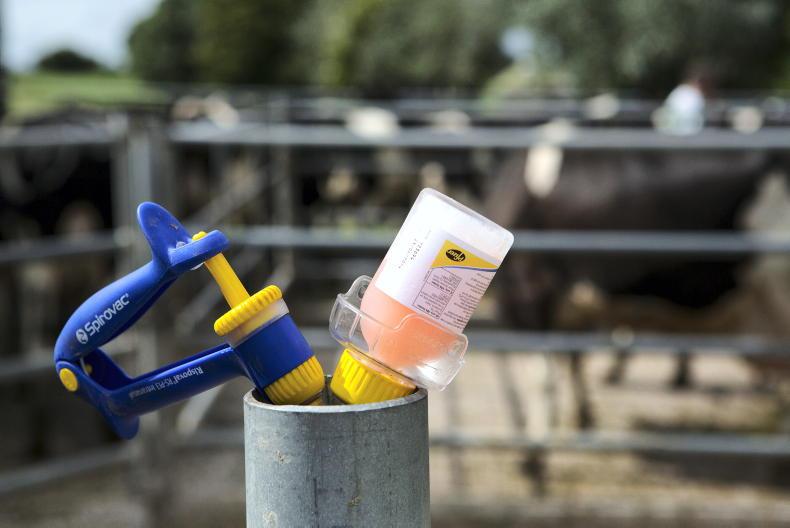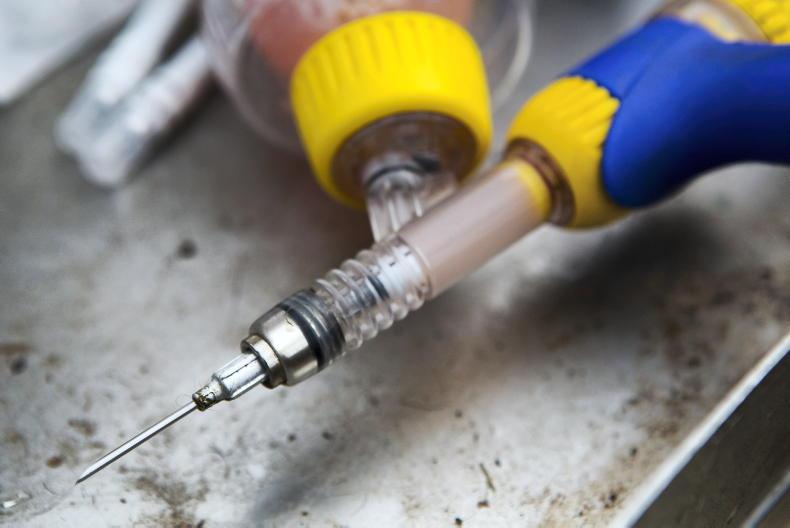One Health is about raising awareness of the challenge that is antibiotic resistance. This is where infectious bacteria develop resistance and the antibiotics we use to treat them are no longer effective. The misuse and overuse of antibiotics in both humans and animals is a key driver of resistance development.
Farmers have a duty to use antibiotics responsibly, as using them in animals can potentially make them less effective in humans. We need to reduce our use of antibiotics on Irish farms through better management and husbandry.
Using vaccines will reduce the need to use antibiotics by reducing the risk of disease outbreaks
Vaccination offers a way of improving animal health by stimulating or improving immunity.
When we look at infectious disease on our farms, it is always a battle between maximising immunity and minimising the amount of infection. Using vaccines will reduce the need to use antibiotics by reducing the risk of disease outbreaks.
Vaccines work by stimulating the immune system to improve immunity against the agent in the vaccine.
This creates an immunological memory of the bug or pathogen. When the animal is then exposed to this bug or pathogen on-farm, they can mount a better immune response.
However, vaccines aren’t a cure-all. They are only part of the solution to the health challenge on our farms.
In some ways, it is about carrying out a cost-benefit analysis, as a treatment for a sick animal also costs money
Vaccines cost money, so we must ensure there is a good return on investment from their use. In some ways, it is about carrying out a cost-benefit analysis, as a treatment for a sick animal also costs money.
There is also the underlying cost of poor performance and ill thrift in the future, as a result of the animal being sick. Used correctly, vaccines are like insurance policies – without them, the risk of disease can be much greater.
Here are some key points we must remember when using vaccines:
Timing is key. Vaccines stimulate and create immunity. Vaccination should be done before the challenge of disease occurs. For example, where we are trying to control pneumonia at housing or weaning, the vaccine course should be given before the period of risk at housing occurs. This allows the maximum level of immunity before the risk period.Work with your vet, to develop the best vaccine programme for your farm. Your vet will have knowledge of the disease risks for your farm, as well as the animal herd health status. Vaccination should be a key focus of your annual herd health plan.Store vaccines correctly. Most vaccines require cold storage between 2°C and 4°C. Ensure all vaccines are stored out of sunlight, and kept refrigerated where required. Hygiene with needles and administration helps prevent damage to the reactive agents in the vaccine.Always read the label carefully. This will contain vital information, particularly around handling and storage. It will also describe which route of administration to use.Use vaccines on healthy animals where possible to get the maximum value and immunity. We can use live vaccines occasionally during disease outbreaks, but this is best avoided, particularly where animals have high temperatures.Administer vaccines in the correct way and follow the right protocols around timing and dosing. Many vaccines require two doses to begin with, to maximise immunity. It is important that you find out from your vet what the protocol is and follow the recommended instructions carefully.Use diagnostics such as post-mortems, blood tests and milk samples to regularly monitor what infectious diseases may be active in your herd. This means you can be more strategic when deciding what vaccines might be appropriate.Vaccines won’t work well where there are significant infection challenges, poor hygiene and substandard husbandry, so talking with your vet is vital.Prevention is always better than cure. It’s far more cost effective to spend money on an effective vaccination programme rather than incurring the cost of treating sick animals and the associated losses in terms of vet bills and reduced animal performance.
One Health is about raising awareness of the challenge that is antibiotic resistance. This is where infectious bacteria develop resistance and the antibiotics we use to treat them are no longer effective. The misuse and overuse of antibiotics in both humans and animals is a key driver of resistance development.
Farmers have a duty to use antibiotics responsibly, as using them in animals can potentially make them less effective in humans. We need to reduce our use of antibiotics on Irish farms through better management and husbandry.
Using vaccines will reduce the need to use antibiotics by reducing the risk of disease outbreaks
Vaccination offers a way of improving animal health by stimulating or improving immunity.
When we look at infectious disease on our farms, it is always a battle between maximising immunity and minimising the amount of infection. Using vaccines will reduce the need to use antibiotics by reducing the risk of disease outbreaks.
Vaccines work by stimulating the immune system to improve immunity against the agent in the vaccine.
This creates an immunological memory of the bug or pathogen. When the animal is then exposed to this bug or pathogen on-farm, they can mount a better immune response.
However, vaccines aren’t a cure-all. They are only part of the solution to the health challenge on our farms.
In some ways, it is about carrying out a cost-benefit analysis, as a treatment for a sick animal also costs money
Vaccines cost money, so we must ensure there is a good return on investment from their use. In some ways, it is about carrying out a cost-benefit analysis, as a treatment for a sick animal also costs money.
There is also the underlying cost of poor performance and ill thrift in the future, as a result of the animal being sick. Used correctly, vaccines are like insurance policies – without them, the risk of disease can be much greater.
Here are some key points we must remember when using vaccines:
Timing is key. Vaccines stimulate and create immunity. Vaccination should be done before the challenge of disease occurs. For example, where we are trying to control pneumonia at housing or weaning, the vaccine course should be given before the period of risk at housing occurs. This allows the maximum level of immunity before the risk period.Work with your vet, to develop the best vaccine programme for your farm. Your vet will have knowledge of the disease risks for your farm, as well as the animal herd health status. Vaccination should be a key focus of your annual herd health plan.Store vaccines correctly. Most vaccines require cold storage between 2°C and 4°C. Ensure all vaccines are stored out of sunlight, and kept refrigerated where required. Hygiene with needles and administration helps prevent damage to the reactive agents in the vaccine.Always read the label carefully. This will contain vital information, particularly around handling and storage. It will also describe which route of administration to use.Use vaccines on healthy animals where possible to get the maximum value and immunity. We can use live vaccines occasionally during disease outbreaks, but this is best avoided, particularly where animals have high temperatures.Administer vaccines in the correct way and follow the right protocols around timing and dosing. Many vaccines require two doses to begin with, to maximise immunity. It is important that you find out from your vet what the protocol is and follow the recommended instructions carefully.Use diagnostics such as post-mortems, blood tests and milk samples to regularly monitor what infectious diseases may be active in your herd. This means you can be more strategic when deciding what vaccines might be appropriate.Vaccines won’t work well where there are significant infection challenges, poor hygiene and substandard husbandry, so talking with your vet is vital.Prevention is always better than cure. It’s far more cost effective to spend money on an effective vaccination programme rather than incurring the cost of treating sick animals and the associated losses in terms of vet bills and reduced animal performance.









SHARING OPTIONS